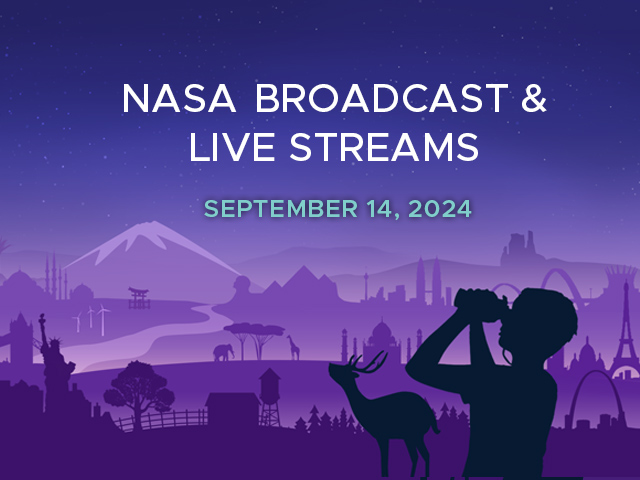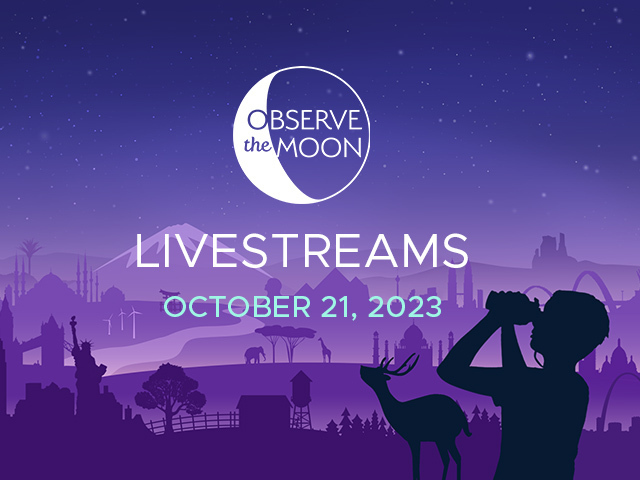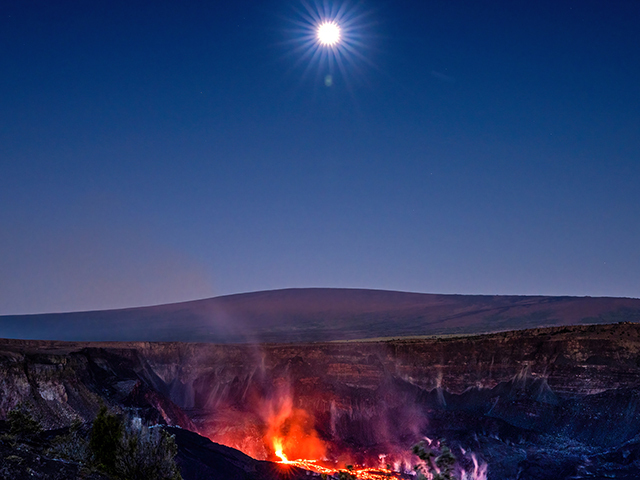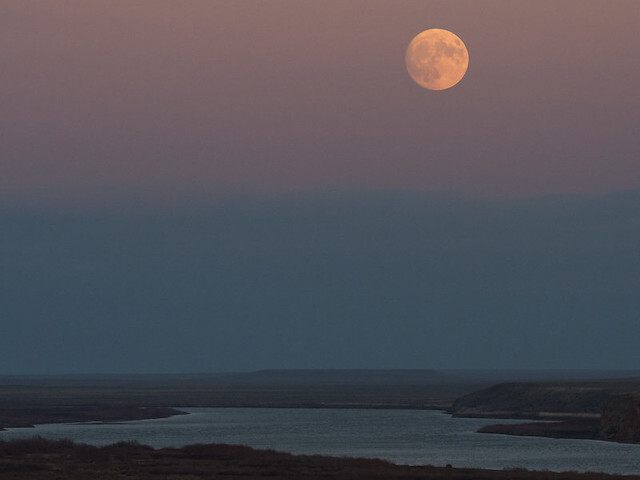News | August 1, 2023
The Next Full Moon is a Supermoon; the Sturgeon Moon
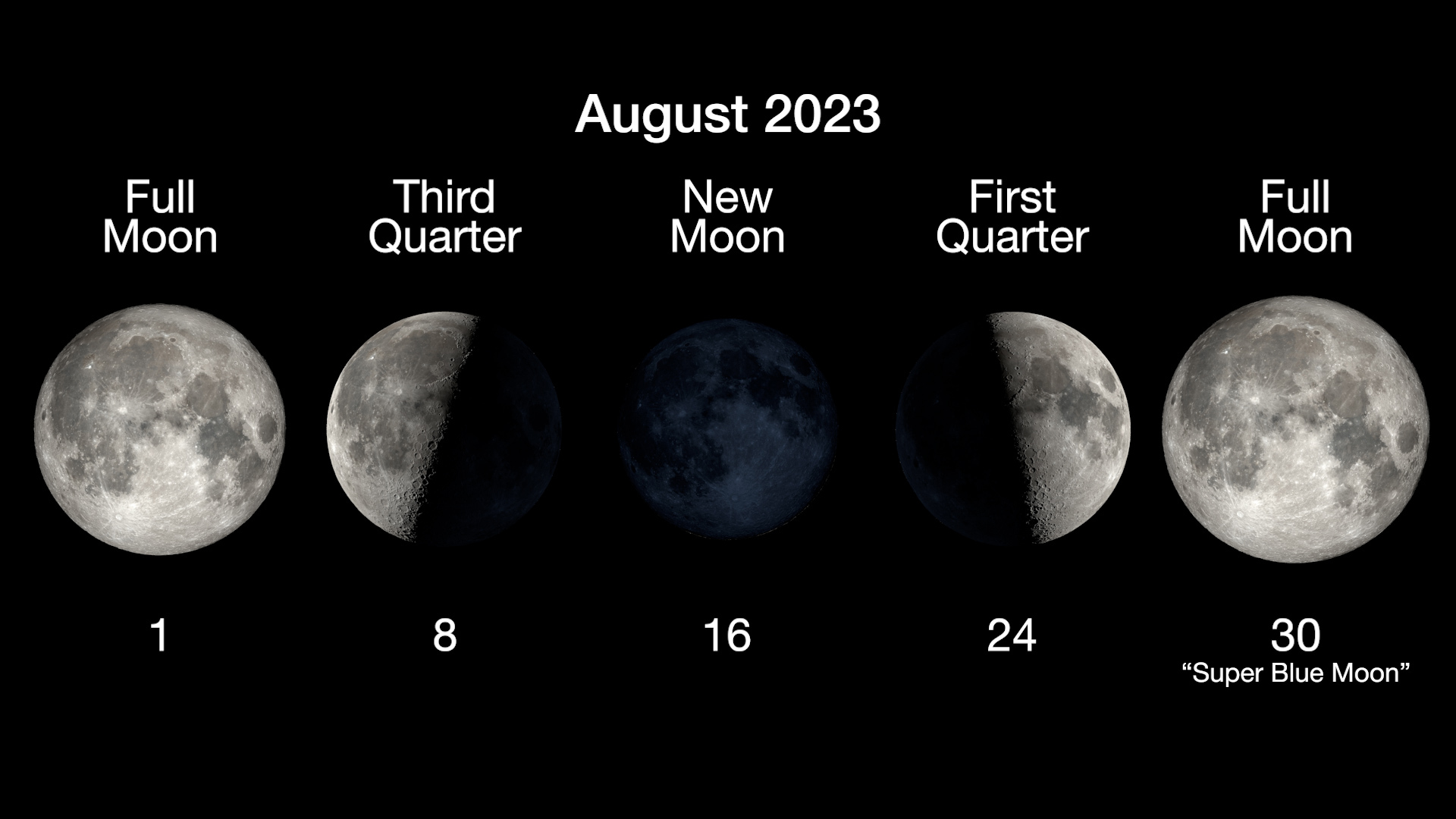
The phases of the Moon for August 2023. Credit: NASA/JPL-Caltech
The Next Full Moon is a Supermoon; the Sturgeon Moon; the Red, Corn, Green Corn, Barley, Herb, Grain, or Dog Moon; and Esala Poya and the start of Vassa.
The next full Moon will be on Tuesday afternoon, August 1, 2023, appearing opposite the Sun in Earth-based longitude at 2:32 PM EDT. This will be on Wednesday morning from the India Standard Time zone eastward to the International Date Line. The Moon will appear full for 3 days around this time, from early Monday morning to early Thursday morning.
This will be a supermoon. Different publications use different thresholds for deciding which Moons qualify as "super." In 2023, some publications recognize four supermoons (the full Moon in July, the two full Moons in August, and the full Moon in September), while others recognize only the two brightest supermoons, this full Moon and the next at the end of August. The term "supermoon" was coined by astrologer Richard Nolle in 1979 as either a new or full Moon that occurs when the Moon is within 90% of perigee, its closest approach to Earth. Since we can't see new Moons (except when they block the Sun), what has caught the public's attention in recent decades are full supermoons, as these are the biggest and brightest full Moons of the year.
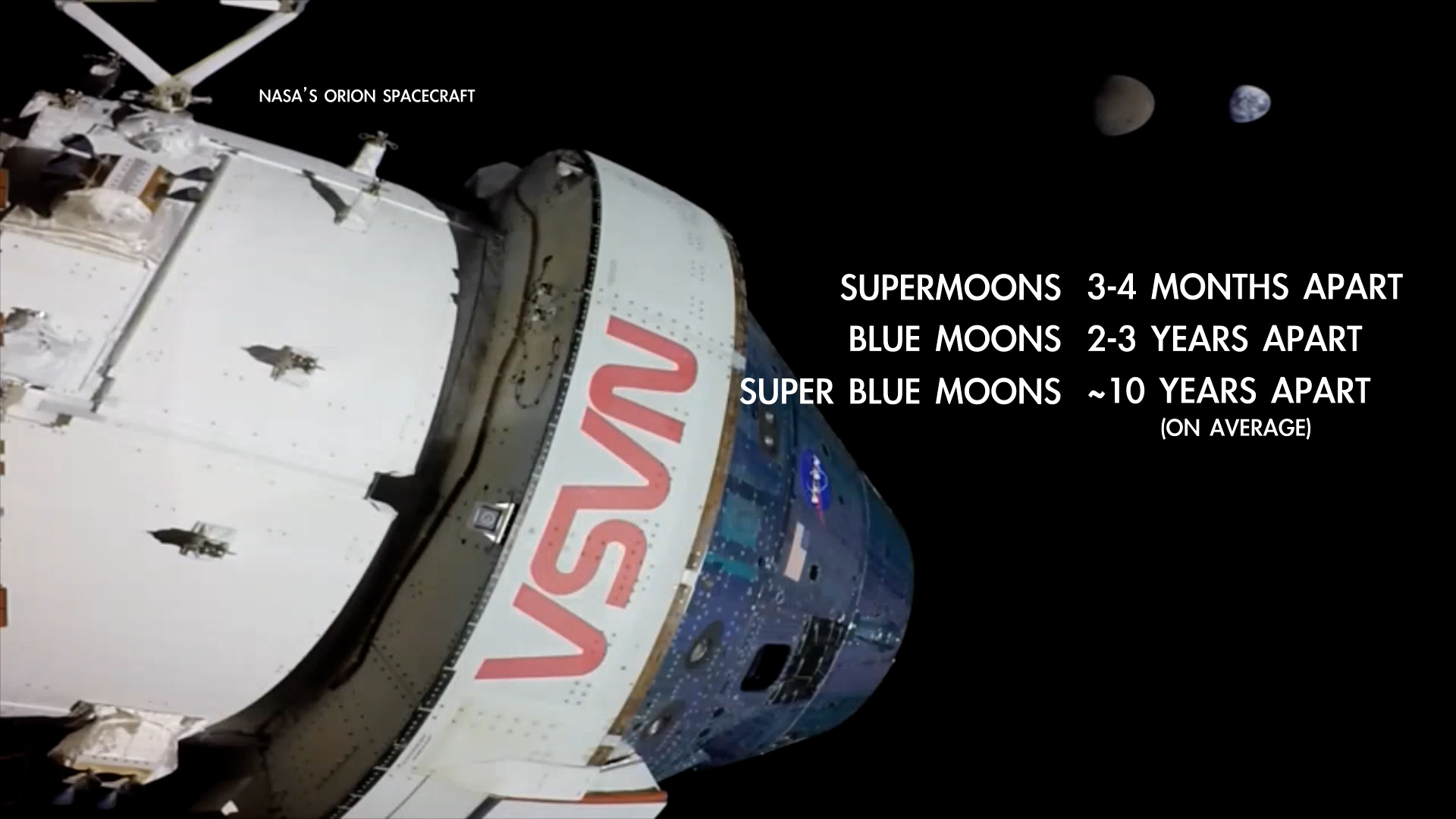
The Maine Farmer's Almanac began publishing "Indian" names for full Moons in the 1930s and these names have become widely known and used. According to this almanac, as the full Moon in August the Algonquin tribes in what is now the northeastern USA called this the Sturgeon Moon, after the large fish in the Great Lakes and other major bodies of water that were more easily caught this time of year. Other names reported for this Moon include the Red Moon, the Corn or Green Corn Moon, the Barley Moon, the Herb Moon, the Grain Moon, and the Dog Moon.
Every full Moon is a holiday in Sri Lanka. In 2023 there are two Esala Poya holidays, Adhi Esala Poya on July 3 and this full Moon, Esala Poya, both commemorating Buddha's first sermon after reaching nirvana, which started Buddhism. This sermon became the core of Buddhist teachings and includes the four noble truths. In addition, with this full Moon the Buddhist Monks start Vassa, the annual three-month retreat during the rainy season.
In many traditional lunisolar and lunar calendars the full Moons fall on or near the middle of the lunar months. This full Moon is in the middle of the sixth month of the Chinese calendar, Av in the Hebrew calendar, and Muharram in the Islamic calendar. Muharram is the first month of the Islamic year and one of the four sacred months during which warfare is forbidden.
For Science Fiction fans, a note on the author Theodore Sturgeon (in honor of the Sturgeon Moon). According to Wikipedia, Theodore Sturgeon wrote over 200 stories, mostly science fiction but some horror and mystery tales. For Star Trek fans, his scripts introduced important concepts into the series, although only two of his scripts were produced. His Star Trek scripts introduced "pon far," the Vulcan hand symbol, the phrase "live long and prosper," and (in a script that was not produced but that influenced later scripts) the "Prime Directive."
As usual, the wearing of suitably celebratory celestial attire is encouraged in honor of the full Moon. Enjoy the supermoon, avoid starting any wars, and consider reading some Theodore Sturgeon.
As for other celestial events between now and the full Moon after next (with specific times and angles based on the location of NASA Headquarters in Washington, DC):
As summer continues the daily periods of sunlight continue to shorten. On Tuesday, August 1, 2023 (the day of the full Moon), morning twilight will begin at 5:03 AM EDT, sunrise will be at 6:09 AM, solar noon will be at 1:14 PM when the Sun will reach its maximum altitude of 69.1 degrees, sunset will be at 8:19 PM, and evening twilight will end at 9:25 PM. By Wednesday, August 30 (the day of the full Moon after next), morning twilight will begin at 5:35 AM, sunrise will be at 6:35 AM, solar noon will be at 1:09 PM when the Sun will reach its maximum altitude of 60.0 degrees, sunset will be at 7:42 PM, and evening twilight will end at 8:42 PM.
This should be a good year for the annual Perseid meteor shower. Under ideal conditions the Perseids (007 PER) can produce about 100 visible meteors per hour at its peak, making it potentially one of the three best meteor showers of the year (the others being the Quadrantids in early January and the Geminids in mid December). The Perseids have a broad activity rate predicted to peak on Sunday, August 13, 2023, between 2 AM and noon (in EDT). This range may be wider, as the International Meteor Organization (IMO) reports past observations show a range equivalent to from 9 PM on August 12 to 4 PM on August 13. With these predictions and the viewing and lighting conditions for the Washington, DC area, the best time to look for these meteors should be after 10 or 11 PM on Saturday night (when the radian has risen high enough to see these meteors) until moonrise on Sunday morning (at 3:18 AM). The peak is broad, and in past years high activity has been reported well after, so keep an eye on the sky between 10 PM and moonrise for the nights before and after this predicted peak. The Perseid meteor shower is caused by dust from the comet 109P/Swift-Tuttle entering our atmosphere at 59 kilometers per second (132,000 miles per hour), so fast that air gets compressed and heated until it glows white hot.
The best conditions for viewing these meteors would be if the weather is clear with no clouds or high hazes, you are in a place far from any light sources or urban light pollution, and you have a clear view of a wide expanse of the sky. Be sure to give your eyes plenty of time to adapt to the dark. The rod cells in your eyes are more sensitive to low light levels but play little role in color vision. Your color-sensing cone cells are concentrated near the center of your view with more of the rod cells on the edge of your view. Since some meteors are faint, you will tend to see more meteors from the "corner of your eye" (which is why you need a view of a large part of the sky). Your color vision (cone cells) will adapt to darkness in about 10 minutes, but your more sensitive night vision will continue to improve for an hour or more (with most of the improvement in the first 35 to 45 minutes). The more sensitive your eyes are, the more chance you have of seeing meteors. Even a short exposure to light (from passing car headlights, etc.) will start the adaptation over again (so no turning on a light or your cell phone to check what time it is).
The other two meteor showers peaking during this lunar cycle are predicted to display at most 3 visible meteors per hour, too few to be visible from our artificially lit urban areas.
Evening Sky Highlights
On the evening of Tuesday, August 1, (the night of the full Moon), as evening twilight ends (at 9:25 PM EDT), the rising full Moon will be 5 degrees above the southeastern horizon. Two of the five visible planets will be in the sky, bright Mercury just 1/2 degree above the west-northwestern horizon and Mars at 5 degrees above the western horizon. The bright star appearing closest to overhead will be Vega, the brightest star in the constellation Lyra the lyre, at 71 degrees above the eastern horizon. Vega is one of the three bright stars in the Summer Triangle (along with Deneb and Altair). Vega is the 5th brightest star in our night sky, about 25 light-years from Earth, has twice the mass of our Sun, and shines 40 times brighter than our Sun.
As this lunar cycle progresses, the background of stars will appear to shift westward each evening (as the Earth moves around the Sun), while the planets Mercury and Mars hover near the western horizon. Rising a few minutes after evening twilight ends, the waning Moon will be near Saturn on August 2. Starting August 4 Saturn will be above the horizon as evening twilight ends. August 7 will be the last evening that Mercury will be above the western horizon as evening twilight ends, although it will remain visible in the glow of dusk for another week or so. The waxing Moon will pass by Mars on August 18, Spica on August 20 and 21, and Antares on August 24 (the Moon will actually block Antares from view for much of Canada, the US, and northern Mexico). The planet Saturn will be at its closest and brightest for the year on August 27.
By the evening of Wednesday, August 30, (the night of the full Moon after next), as evening twilight ends (at 8:42 PM EDT), the rising full Moon will be 8 degrees above the east-southeastern horizon with the planet Saturn 5 degrees to the upper right. The planet Mars will be setting on the western horizon. The bright star appearing closest to overhead still will be Vega at 85 degrees above the eastern horizon.
Morning Sky Highlights
On the morning of Tuesday, August 1, (the morning of the full Moon), as morning twilight begins (at 5:03 AM EDT), the setting full Moon will be 4 degrees above the southwestern horizon. Two of the visible planets will be in the sky, bright Jupiter at 52 degrees above the east-southeastern horizon and Saturn at 33 degrees above the southwestern horizon. At 52 degrees Jupiter will also be the bright object closest to overhead.
As this lunar cycle progresses, Jupiter, Saturn, and the background of stars will appear to shift westward each evening. The waning Moon will appear near Saturn on August 3, Jupiter on August 8, the Pleiades star cluster on August 9, and Pollux on August 13 and 14. A good time to see the annual Perseid meteor shower should be after 11 PM on August 12 to before moonrise the morning of August 13. After mid-August the bright planet Venus will begin emerging from the glow of dawn and will rise before morning twilight begins starting August 24. The planet Saturn will be at its closest and brightest for the year on August 27.
On the morning of Wednesday, August 30, (the morning of the full Moon after next), as morning twilight begins (at 5:35 AM EDT), the setting full Moon will be 1 degree above the west-southwestern horizon with the planet Saturn 8 degrees above the Moon. The other two visible planets will be bright Jupiter at 66 degrees above the southern horizon and the even brighter Venus at 8 degrees above the eastern horizon. At 66 degrees Jupiter will be the bright object closest to overhead (with the bright star Capella a close second at 64 degrees above the east-northeastern horizon).
Detailed Daily Guide
Here for your reference is a day-by-day listing of celestial events between now and the full Moon after next. The times and angles are based on the location of NASA Headquarters in Washington, DC, so some of these details may differ for your location (I use parentheses to indicate times specific to the DC area).
In late July 2023 the planets Venus, Mercury, and Mars will appear together low on the western horizon along with the bright star Regulus. On Thursday evening, July 27, the bright planets Venus and Mercury will be at their closest, less than 5 degrees apart on the western horizon. Try looking from about 30 minutes after sunset (after 8:54 PM EDT) but before Venus sets 15 minutes later (at 9:09 PM). Venus will be the brightest, but also the lowest in the sky. Mercury (2nd in brightness) will appear less than 5 degrees to the upper right of Venus, with the star Regulus (3rd in brightness) to the upper left of Mercury and the planet Mars (4th in brightness and difficult to see in the glow of dusk) farther to the upper left. By the time evening twilight ends (at 9:31 PM) Mercury will be just 4 minutes from setting (at 9:35 PM).
Friday evening, July 28, 2023, very low on the west-northwestern horizon, the bright star Regulus will appear just 0.14 degrees to the upper right of the planet Mercury. As evening twilight ends (at 9:30 PM EDT) the pair will be 0.5 degrees above the horizon and they will set 4 minutes later. Mars will appear to the upper left of the pair.
Also on Friday night into Saturday morning, July 28 to 29, 2023, the bright star Antares will appear to the right of the waxing gibbous Moon. The Moon will be 24 degrees above the southern horizon as evening twilight ends (at 9:30 PM EDT) with Antares about 5 degrees to the right. Antares will set first on the southwestern horizon a little more than 4 hours later (at 1:41 AM).
As mentioned above, the next full Moon will be on Tuesday afternoon, August 1, 2023, at 2:32 PM EDT. Since this full Moon is less than 12 hours before perigee (when the Moon is closest to the Earth in its orbit), this will be a supermoon. The Moon will appear full for 3 days around this time, from early Monday morning into early Thursday morning.
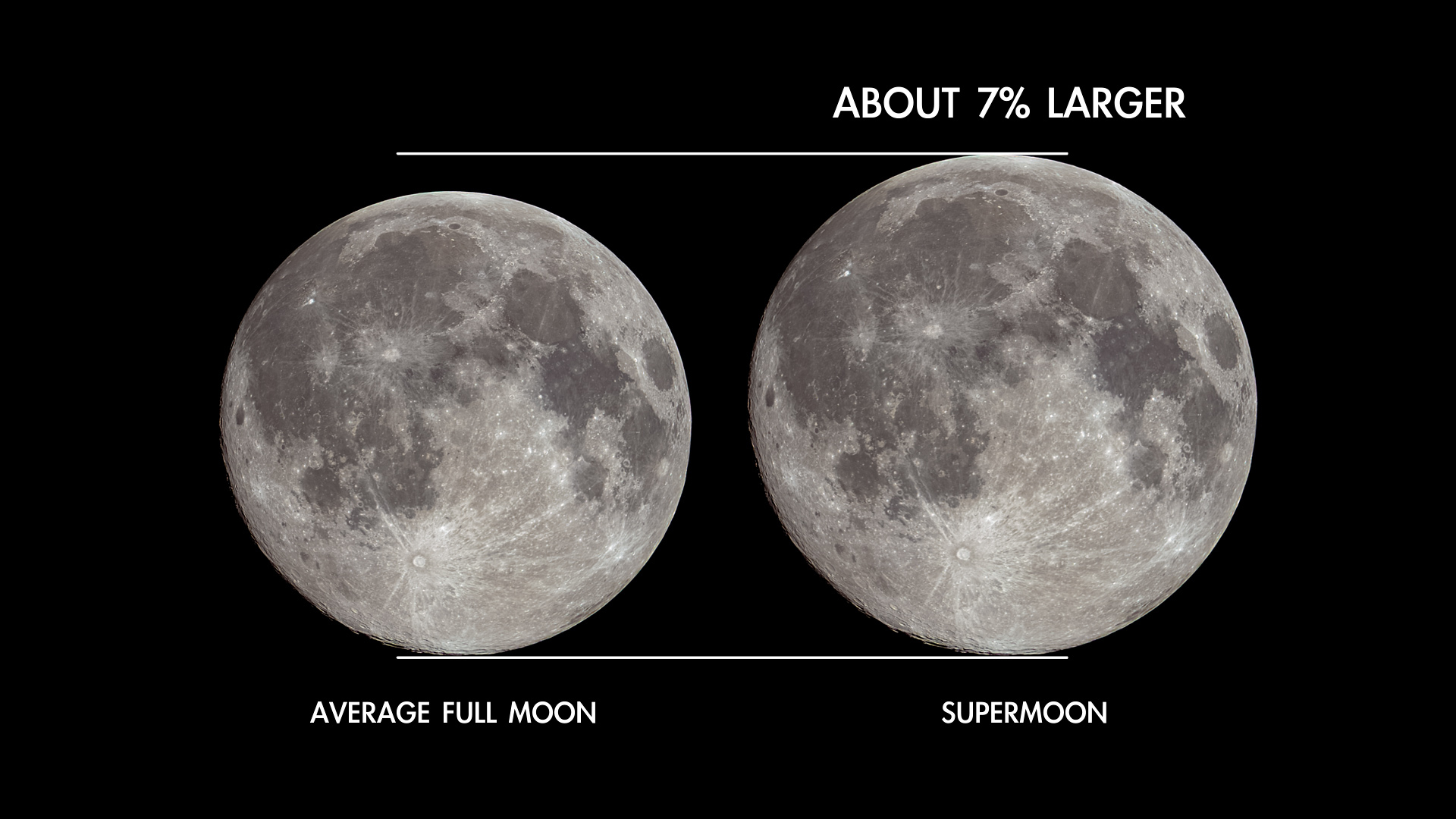
Early Wednesday morning, August 2, 2023, at 1:53 AM EDT, the Moon will be at perigee, its closest to the Earth for this orbit.
Wednesday night into Thursday morning, August 2 to 3, 2023, the planet Saturn will appear near the waning gibbous Moon. Saturn will be 7 degrees to the left of the Moon as they rise on the east-southeastern horizon (at 9:27 PM EDT) just 3 minutes after evening twilight ends. The Moon will reach its highest in the sky for the night (at 2:45 AM) with Saturn 5 degrees to the upper left. Saturn will be about 4 degrees to the upper right of the Moon by the time morning twilight begins (at 5:05 AM).
Friday evening, August 4, 2023, will be the first evening that the planet Saturn will be above the east-southeastern horizon as evening twilight ends (at 9:21 PM EDT).
Monday evening, August 7, 2023 will be the last evening that the planet Mercury will be (barely) above the western horizon as evening twilight ends (at 9:17 PM EDT).
Tuesday morning, August 8, 2023, the planet Jupiter will appear near the waning half-Moon. As Jupiter rises on the east-northeastern horizon (Monday night at 11:59 PM EDT) it will be a little more than 2 degrees below the Moon. Jupiter will be 3 degrees to the lower right of the Moon as morning twilight begins (at 5:11 AM).
Tuesday morning, August 8, 2023, the waning Moon will appear half-full as it reaches its last quarter at 6:29 AM EDT.
Wednesday morning, August 9, 2023, the Pleiades star cluster will appear to the left of the waning crescent Moon. They will be 6 degrees apart as they rise on the east-northeastern horizon just after midnight (at 12:15 AM EDT) and will shift towards each other as the morning progresses. By the time morning twilight begins (at 5:12 AM) the Pleiades will be 3 degrees to the left of the Moon. For those of us living in light-polluted urban areas, the Pleiades may be hard to see.
Wednesday evening, August 9, 2023, will be when the planet Mercury reaches its greatest angular separation from the Sun as seen from the Earth for this apparition (called greatest elongation), appearing half-lit through a large enough telescope. Because the angle of the line between the Sun and Mercury and the horizon changes with the seasons, the date when Mercury and the Sun appear farthest apart as seen from the Earth is not the same as when Mercury appears highest above the west-northwestern horizon as evening twilight ends, which occurred at the beginning of August.
As mentioned above, the best time to see the annual Perseid meteor shower should be Saturday night, August 12, 2023, after 10 or 11 PM local time (when the radiant has risen high enough to see these meteors), until moonrise on Sunday morning, August 13 (at 3:18 AM EDT). The peak is broad and in past years high activity has been reported well after the peak, so keep an eye on the sky between 10 PM and moonrise for the nights before and after the predicted peak.
On Sunday morning, August 13, 2023, the bright star Pollux will appear to the lower left of the waning crescent Moon. When Pollux rises it will be 7 degrees from the Moon on the northeastern horizon (at 3:34 AM EDT). They will be 6 degrees apart by the time morning twilight begins (at 5:16 AM)
Sunday morning, August 13, 2023, the planet Venus will be passing between the Earth and the Sun as seen from the Earth, called inferior conjunction. Planets that orbit inside of the orbit of Earth can have two types of conjunctions with the Sun, inferior (when passing between the Earth and the Sun) and superior (when passing on the far side of the Sun as seen from the Earth). Venus will be shifting from the evening sky to the morning sky and will begin emerging from the glow of dawn on the eastern horizon after mid-August (depending upon viewing conditions).
Monday morning, August 14, 2023, the waning crescent Moon will have shifted to 7 degrees to the lower left of Pollux. The Moon will rise (at 4:17 AM EDT) on the eastern horizon below Pollux an hour before morning twilight begins.
Wednesday morning, August 16, 2023, at 5:38 AM EDT, will be the new Moon, when the Moon passes between the Earth and the Sun and will not be visible from the Earth. The day of or the day after the New Moon marks the start of the new month for many lunisolar calendars. The seventh month of the Chinese calendar starts on Wednesday, August 16. In the Islamic calendar the months traditionally start with the first sighting of the waxing crescent Moon, although many Muslim communities now follow the Umm al-Qura Calendar of Saudi Arabia, which uses astronomical calculations to start months in a more predictable way. Using this calendar, sundown on Wednesday evening, August 16, 2023, will probably mark the start of Safar. Sundown on Thursday, August 17, marks the start of Elul in the Hebrew calendar.
Wednesday morning, August 16, 2023, at 7:55 AM EDT, the Moon will be at apogee, its farthest from the Earth for this orbit.
Friday evening, August 18, 2023, low on the western horizon, the planet Mars will appear 1 degree to the lower left of the thin, waxing crescent Moon. The planet Mercury, appearing brighter than Mars will be about 7 degrees below the Moon. To see them, try looking from 30 minutes after sunset (after 8:29 PM EDT) but before Mercury sets 47 minutes later (at 8:46 PM). Evening twilight will end about an hour after sunset (at 9:01 PM), Mars will set 12 minutes later (at 9:13 PM) followed by the Moon (at 9:19 PM)
Sunday evening, August 20, 2023, the bright star Spica will be 7 degrees to the left of the waxing crescent Moon. They will be 11 degrees above the west-southwestern horizon as evening twilight ends (at 8:58 PM EDT) and the Moon will set first about an hour later (at 10 PM).
Monday evening, August 21, 2023, the waxing crescent Moon will have shifted to appear 7 degrees to the upper left of Spica. The pair will appear to separate until Spica sets (at 10 PM EDT).
Tuesday night, August 22, 2023, will be the night of the seventh day of the seventh month of the Chinese calendar, known as the double seventh festival, Qixi in China, Chilseok in Korea, Thất Tịch in Vietnam. The double seventh festival is sometimes called the Chinese Valentine's Day. There are many variations on the legend, but basically they involve the three bright stars we know as the "Summer Triangle" and the Milky Way. Vega represents the weaver girl and Altair the cowherd. They fall in love and neglect their duties, so the Goddess of Heaven puts a wide river in the sky, the Milky Way, to keep them apart. They are allowed to meet only one night a year, on the seventh night of the seventh month, when Deneb forms a bridge across the Milky Way. In some versions of the legend, the bridge is formed by magpies, so another name is the Magpie Festival. The Japanese Tanabata or Star Festival is related, but is no longer tied to the lunisolar date (it is now celebrated on July 7th, the double seventh of the Gregorian Calendar). On average there are a little more than seven days between each quarter of the Moon, so the seventh day of the lunisolar month is usually just before the first quarter Moon.
Thursday morning, August 24, 2023, will be the first morning that the bright planet Venus (as the morning star) will be above the eastern horizon as morning twilight begins (at 5:31 AM EDT).
On Thursday morning, August 24, 2023, the Moon will appear half-full as it reaches its first quarter at 5:57 AM EDT.
On Tuesday night, August 24, 2023, the bright star Antares will appear near the half-full Moon, so close that for much of Canada, the US, and northern Mexico the Moon will pass in front of Antares. For the Washington, DC area, as evening twilight ends (at 8:52 PM EDT), Antares will be a degree to the left of the Moon. Antares will disappear behind the dark side of the Moon about an hour later (at 10:53 PM). Antares will reappear from the bottom of the Moon about 45 minutes after that (around 11:41 PM) but the bright limb of the Moon will mask this reappearance (at least at first). Antares will set first on the west-southwestern horizon about 14 minutes later (at 11:55 PM).
Saturday morning, August 27, 2023, the planet Saturn will be at its closest and brightest for the year, called "opposition" because it will be opposite the Earth from the Sun, effectively a "full" Saturn. Saturn will be 10 degrees above the east-southeastern horizon as evening twilight ends Friday, August 26 (at 8:48 PM EDT), will reach its highest in the sky early Saturday morning (at 1:13 AM), and will be 11 degrees above the west-southwestern horizon as morning twilight begins (at 5:32 AM). Only planets that orbit farther from the Sun than the Earth can be seen at opposition from the Earth.
Wednesday morning, August 30, 2023, at 11:55 AM EDT, the Moon will be at perigee, its closest to the Earth for this orbit.
The full Moon after next will be Wednesday night, August 30, 2023, at appearing opposite the Sun (in Earth-based longitude) at 9:36 PM EDT. This full Moon will be the second full Moon in August, making it a Blue Moon by the newer definition introduced by Sky & Telescope magazine in 1946. Since this full Moon occurs near when the Moon is closest to the Earth (perigee), this will also be a supermoon. The planet Saturn, just a few days from its closest and brightest for the year, will appear near the Moon. As evening twilight ends (at 8:42 PM) Saturn will be 5 degrees to the upper right of the Moon, and will appear to swing clockwise around the Moon as the evening progresses. The Moon will appear full for 3 days around the time of the full Moon, from Tuesday night to Friday morning.


